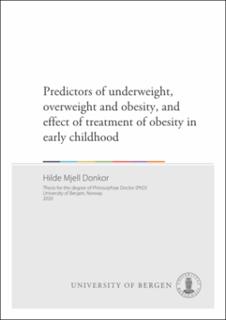| dc.description.abstract | Abstract
Background:
The prevalence of overweight (OW) and obesity (OB) has escalated throughout the world over the last decades, both in children and adults. Childhood OB is a major risk factor for adult OB and the subsequent increased risk of major morbidities secondary to OB. Consequently, research on prevention and early interventions play a key role in order to understand how to curtail this epidemic. To be able to prevent or treat OB in childhood, it is crucial to understand the complexity of causes and risk factors, such as effects of societal and family contributors and psychological mechanisms.
Aims:
The overall aim of this thesis was to investigate associations between the development of unhealthy weights in early childhood and family- and child-related health and behavioural factors, and to test the effect of an intervention program to curtail OB in this age group.
Methods:
The study was based on the Oppland Health and Growth Study (OHGS), which is a cross-sectional study of all the children in the county who met for the school entry health assessment at 5-6 years of age in 2007. Height and weight were measured by midwives at birth, and later by public health nurses and study nurses. Parents of consenting families completed questionnaires on sociodemographic and family- and child-related health and lifestyle factors. They assessed their child’s psychological health with the Strength and Difficulties Questionnaire (SDQ). The public health nurses reported age, sex, height and weight anonymously for the children of families who declined to participate.
In two of the papers we explored the associations between the background factors and the weight categories underweight (UW), overweight (OW) and obesity (OB) of the children at school entry. Children with normal weight (NW) were the reference.
In the third paper, we investigated the effect of a three-year multidisciplinary intervention programme to curtail OB. The program was group-based and only addressed the parents. We recruited children with OB, mostly from the OHGS, from eight of the municipalities for the intervention, while the rest of the OHGS cohort with OB served as controls without any interventions. The main outcome was the change in body mass index standard deviation score (BMI SDS) over the three years. Within the intervention group we also measured skinfolds, waist circumference and 6-minute walk test and assessed potential success factors based on the initial measurements and the background variables.
Results:
The prevalence of UW, OW and OB was 7.8 %, 10.6 % and 3.5 %, respectively, at a mean age (standard deviation -SD) of 5.70 (0.49) years. The parents of 1119 of 1895 eligible children (59%) gave consent and provided background information. The prevalence of UW, OW and OB was slightly lower among the participants.
In bivariate analyses, UW was related to weight, weight SDS and BMI SDS at birth, and BMI of parents and siblings, but none of the sociodemographic or behavioural factors. OW and OB were related to low education and high BMI of parents, mother smoking and having no siblings. In addition, OB was related to exclusive breastfeeding less than 4 months, dental caries, less physical activity than peers, TV in the child’s bedroom, father not working, non-western ethnicity, and living with one caretaker.
In adjusted analyses, UW was only related to the children’s crown-heel-length-SDS and the BMI of the father. OW was associated with birthweight SDS, parental BMI, having no siblings, low maternal education and maternal smoking, and OB to maternal BMI, low maternal education and maternal smoking. The relative risk of overweight or obesity (OWOB) increased with increasing strata of low education and OWOB in the parents.
Psychological symptoms, as assessed with the SDQ, had curvilinear associations between mean scores on the SDQ subscales Emotional Problems and Peer Problems, with higher scores for UW and OB and nadir for normal weight (NW). Furthermore, the Total Difficulties score (TDS) and Total Difficulties above the 90th percentile (TDS90) had similar patterns, and with significantly higher scores for children with UW and OB than NW. However, TDS90 was only significantly associated with UW after adjustments for the socioeconomic and lifestyle variables, and for the children’s difficulties with sleep or fine motor, language or social skills.
In the intervention study, 31 children completed the intervention and 33 the control period. The median decline in BMI SDS was the same in both groups (0.19 BMI SDS). A higher BMI SDS at entry was similarly associated with a larger decline in BMI SDS in both the intervention and control group. None of the other relevant variables were related to the outcome. Within the intervention group, only age and mean skinfold SDS at entry were significantly related to change in BMI SDS.
Conclusions
Since environmental factors were associated with OW and OB, but not with UW, we suggest that the environmental factors were the most important risk factors for OW and OB in preschool children. UW, but not OW or OB, was associated with psychological symptoms after adjusting for environmental factors. Our interpretation is that psychological symptoms were neither a cause nor a consequence of OW or OB, while psychological difficulties may be a cause or a consequence of UW. A three-year multidisciplinary intervention programme had no effect over no intervention on the development of BMI SDS. Hence, early prevention is of vital importance in order to limit the obesity epidemic. | eng |
| dc.relation.haspart | Paper I: Donkor HM, Grundt JH, Júlíusson PB, Eide GE, Hurum J, Bjerknes R, Markestad T. Social and Somatic Determinants of Underweight, Overweight and Obesity at 5 years of Age: A Norwegian Regional Cohort Study. BMJ Open. 2017 Aug 18;7(8):e014548. The article is available in the main thesis. The article is also available at: <a href="https://doi.org/10.1136/bmjopen-2016-014548" target="blank">https://doi.org/10.1136/bmjopen-2016-014548</a> | eng |
